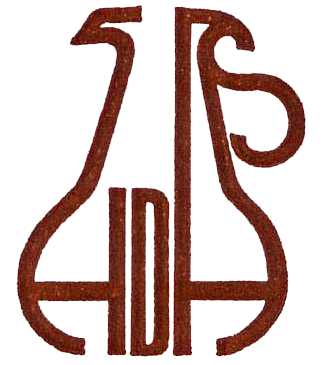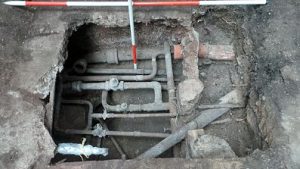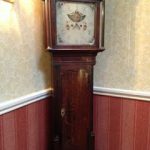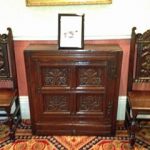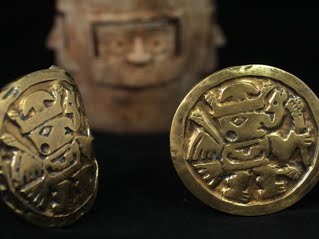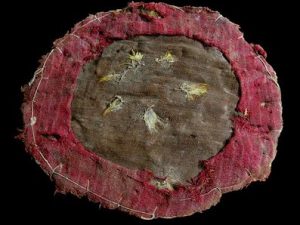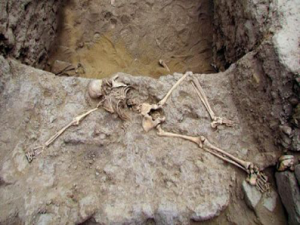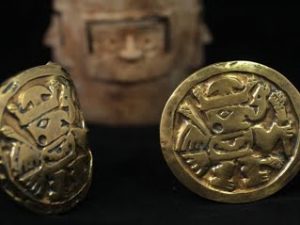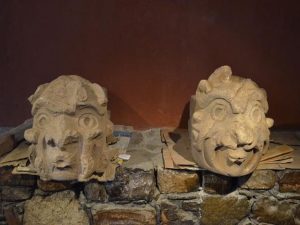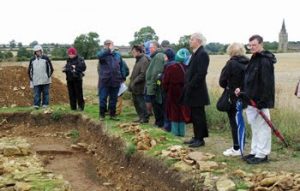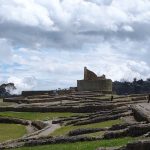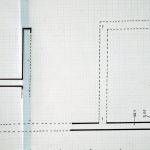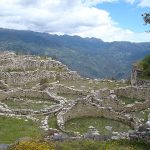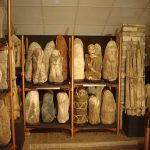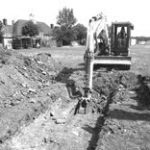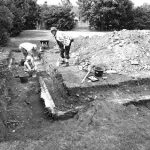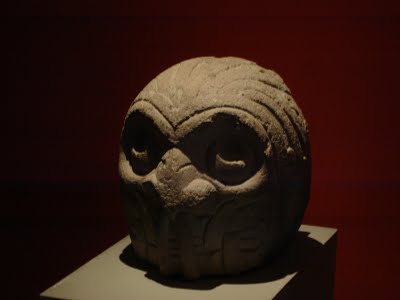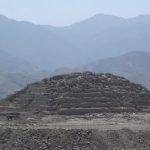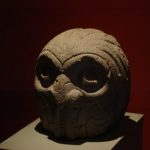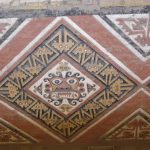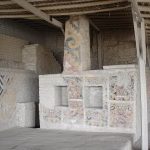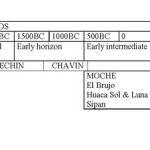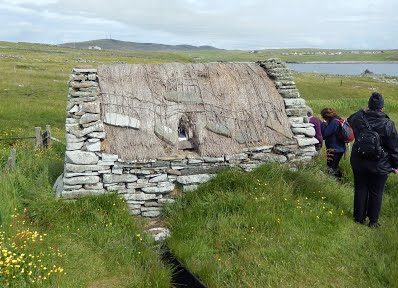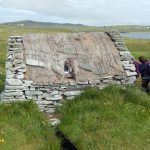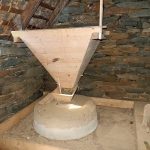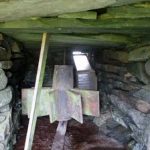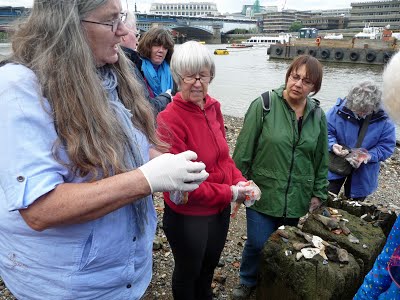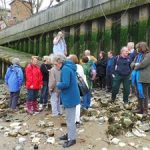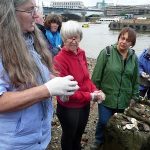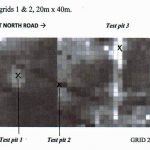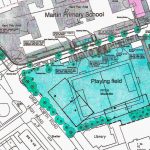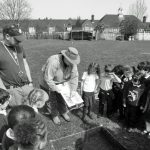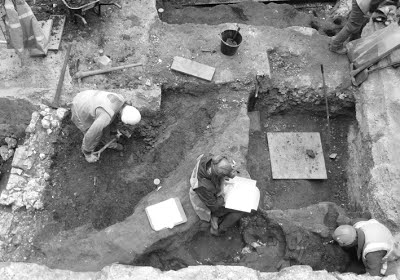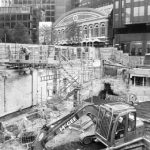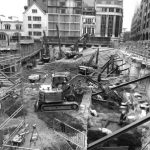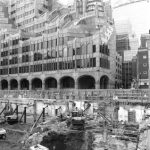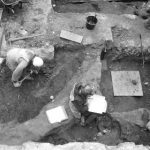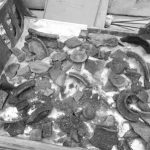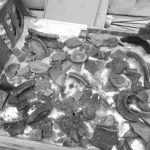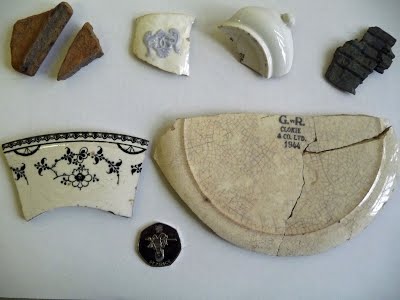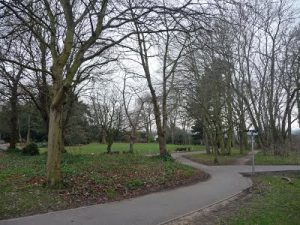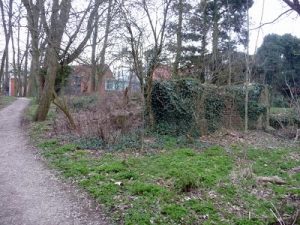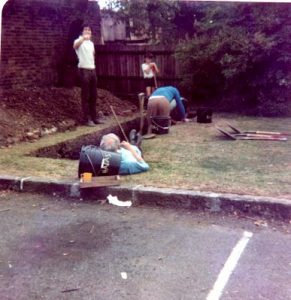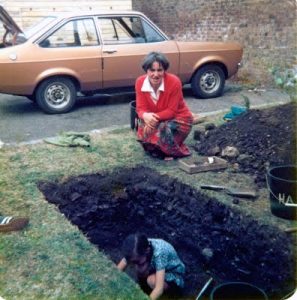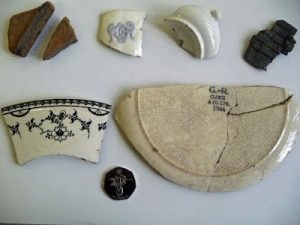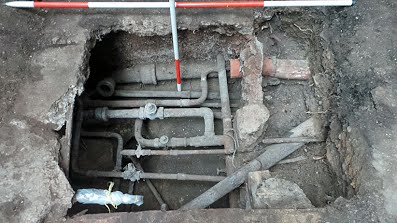
No. 513 December 2013 Edited by Don Cooper
It is Christmas time again! I’ve just looked out my window and somebody has just turned on their Christmas lights, it’s the 11th of November – Grrr. I’m clearly a killjoy. However as this newsletter won’t reach you until the 1st December, May I on behalf of the HADAS community wish you and yours a very happy holiday and a healthy, prosperous and happy 2014. Happy Christmas, Editor
HADAS DIARY 2013 & 2014
All Lectures are held at Avenue House, 17 East End Road, Finchley, N3 3QE, and start promptly at 8.00 pm, with coffee/tea and biscuits afterwards. Non-members welcome (£1.00). Buses 82, 125, 143, 326 & 460 pass nearby and Finchley Central Station (Northern line) is a short walk away.
Tuesday 14th January 2014, 8pm. The Naval Graveyards of Greenwich. Lecture by Malcolm Godfrey. This may change as poor Malcolm has been ill – we wish him a speedy recovery.
Tuesday 11th February 2014. To be announced.
Tuesday 11th March 2014, 8pm. The Sandridge Coin Hoard. Lecture by David Thorold, Curator (Prehistory to Medieval), Verulamium Museum.
Tuesday 8th April 2014, 8pm. Restoring House Mill (working title) Brian James-Strong, River Lea Tidal Mill Trust.
Date for your diaries – The Mary Rose Museum
Many of us have been looking forward to visiting the newly reopened Mary Rose museum in Portsmouth docks, we have now arranged a date for this trip. It is Thursday, 15th May 2014. If you would like to come please let us know in good time. We will travel by coach and spend the day at Portsmouth dock visiting the Mary Rose Museum, Nelson’s HMS. Victory and HMS. Warrior. With an overall ticket for all the attractions and including the coach the cost is expected to be about £45 per person.
H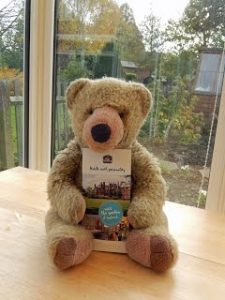 ADAS LONG OUTING 2014 – another date for your diary
ADAS LONG OUTING 2014 – another date for your diary
During our trip to Buxton, we indicated that we hoped to go to Kent in 2014. We have now found a suitable hotel. No dates in September were available, so we have booked from Sunday 29th June returning home on Thursday 3rd July, You never know we might get good weather! The Hotel, approved by Ted, a regular member of our group, is the Best Western Abbots Barton Hotel in Canterbury (www.bestwestern.co.uk/Abbots_Barton). More details next month, but it is likely that the costs will not exceed 2013.
A New Book by a HADAS member
Jennie Lee Cobban has re-written her book, Geoffrey de Mandeville and London’s Camelot, Ghosts, Mysteries and the Occult in Barnet, which she first published in 1997. Additional information and illustrations have been added and the revised volume is now published and is available locally from Barnet Museum.
See also:carnegiepublishing.co.uk/2012/01/jennie-lee-cobban/
https://twitter.com/JennieLeeCobban/status/396042821880532992
Judy Kazarnovsky – an obituary
We’re very sad to report that Judy Kazarnovsky died in October after a brave and lengthy battle with cancer. She was surrounded and supported by her family. Judy, who often thoughtfully used the name Judy Kaye just to make our life easier, was for a time a most helpful HADAS Membership Secretary. She had many other interests, including support of a charity active in health education in West Africa.. HADAS has made a donation in her memory to the North London Hospice in Finchley, where her family say she was looked after with wonderful devotion and care during her last few days.
Newsletter Editor: You can do it
Our Newsletter rota of 12 editors – one each month – is actually one short. Can you volunteer to take this on? It’s just once a year and very good experience – please contact Sue Willetts (sue.willetts@london.ac.uk) or Mary Rawitzer (mary.rawitzer@talktalk.net; Tel: 020 8340 7434) for more information. Basically, it mainly involves putting together e-mailed and hand-written items in a simple framework, with help and advice available. Your Newsletter Needs You!
HADAS NEWS
There is a planning application being prepared to develop land west of Edgwarebury Farm House as an 18-hole golf course see http://acolaidpublic.barnet.gov.uk/online-applications/ and search for H/04377/13. The site is very near the Roman site at Brockley Hill.
HADAS has submitted the following comment:
“I would like to make the following comment on behalf of the Hendon and District Archaeological Society (HADAS) of which I am chairman. The proposed site is close to the important Roman site at Brockley Hill. The Brockley Hill site has been much excavated and published as a pottery manufacturing site, however, many areas of the site have not been discovered particularly where the workers at the site lived with all the attendant facilities of their lives. It is at least probable that some heritage remains will be lost if this site is not properly investigated. Therefore we believe that a strong archaeological condition should be applied to this project. Should this condition be applied we would have no further objections on heritage grounds.”
Continuing the golf course theme, there are proposals by Old Ford Golf Course to re-landscape part of the course using landfill. Using landfill in this sensitive area, the possible site of the Battle of Barnet in 1471, would potentially damage important archaeology. The land is owned by Barnet Council and it is hoped that should such a proposal proceed to planning, at the very least, a strong archaeological condition would be applied.
HADAS have been excavating at Avenue House, East End Road, Finchley. We were commissioned by Avenue House management to excavate and explore a suspicious depression to the north of the 1880s water tower. The hope was that we might find an entrance to the tower or, perhaps, the area where the pump, which was used to lift water up to the top of the tower, had been. No such luck all we found were pipes.
We also dug a small trench where a probably laundry/wash house was sited. There will be a full report in a future newsletter.
Excavation is starting at Barnet Courthouse and HADAS hope to be able to site-watch although it is expected that much of the archaeology will have been destroyed by the building.
Barnet and District Historical Society and Barnet Museum have asked HADAS to assist them in recording the fill-in male and female public toilets beside the museum as it is possible they were on the site of the Old Barnet Brewery cellars.
Note: Barnet Museum have produced a lovely calendar for 2014 full of old photos of Barnet – A Christmas present perhaps?
Roman’s in Kingsbury – with thanks to the Brent and Kilburn Times of 14th November and Nathalie Raffray.
Excavations by Archaeology South East (ASE) on the corner of Blackbird Hill and Old Church Lane on the site of the Blackbird pub (recently the Blarney Stone) turned up a pit and an amount of Roman pottery fragments. These, with the Roman hypocaust tiles in the fabric of the Old St Andrew’s Church in Kingsbury, would seem to indicate the presence of a Roman building somewhere in the immediate surrounding area.
Martin School air-raid shelter – an update. By Bill Bass
Roger Chapman continues his search through documentary records, the latest resource we have been looking at is aerial-photography, and an RAF photo from 1946 has turned-up. This appears to show possible signage and a surface entrance from the Great North Road leading to the centre of the buried shelter complex where a covered building may have steps leading down into the shelter. The southern half of the complex appears to be larger than the northern half. Some other smaller structures seen maybe vents or emergency exits. Transposing our survey – the plan and map work over the photo, the features align quite well together. The photo does seem to infer that the shelter was intact and a going concern throughout the war period, being demolished sometime after.
Some further questions we could ask – when was it demolished and backfilled, was one half used for the general public and the other for the school. Was there a dedicated entrance for the school? How do the above ground shelters relate to the buried ones? There some other earthworks which are directly adjacent to the shelter, what are these?
We will probably return to the school for further fieldwork and survey, and to excavate the main entrance and answer some of the queries.
More work needs to be done on the photo as it has only recently come to hand.
Latest news from historic Deptford by Stewart Wild
I reported in the HADAS newsletter in September this year – “Support for the ambitious Build the Lenox project, Deptford” – that part of the regeneration proposals at Convoys Wharf, Deptford, included restoration of nearby Sayes Court Gardens.
The Gardens were created around 1670 by diarist and horticulturist John Evelyn (1620–1706) and in the 1880s they played a key role in the foundation of the National Trust a decade later. The name probably comes from Geoffrey de Saye (1135–1214), Lord of West Greenwich, or from his son, also Geoffrey de Saye (1155–1230).
Deptford owes its name to the deep ford which crossed the River Ravensbourne near its influx into the Thames before it widened into Deptford Creek. The dockyard dates from 1513 when young Henry VIII established the King’s Yard here to build and provide maintenance for his growing navy; the Mary Rose was launched from here in 1517.
The Deptford Dockyard area has since 2000 been the heart of an extensive regeneration project by developer Hutchison Whampoa, owned by a Chinese billionaire, whose plans have met with considerable local opposition. However, in October this year, encouraged by the National Trust and the Council for British Archaeology, the World Monuments Fund placed the whole site including the Gardens on its watch list of areas with notable heritage.
A little history
In 1651 John Evelyn was given by King Charles II a long lease on a large plot of land by the dockyard with permission to create a house with French and Italian gardens, hundreds of trees, a parterre and terrace walk, ornamental lake, orchard, herb garden, orangery and even beehives. Sadly, none of this survives today and we only know of its splendour from letters written by Evelyn at the time.
Another famous historical character associated with the area is the Dutch-born sculptor and wood carver Grinling Gibbons (1648–1721), who rented a cottage here from Evelyn in 1671. Evelyn wrote in his diary: “I saw the young man at his carving, by the light of a candle. I saw him to be engaged on a carved representation of Tintoretto’s Crucifixion, which he had in a frame of his own making.”
Later that same evening, Evelyn described what he had seen to Sir Christopher Wren. Wren and Evelyn then introduced Gibbons to Charles II who gave him his first commission, which still resides today in the dining room at Windsor Castle.
In 1694 Evelyn vacated his London estate and moved back to his birthplace Wotton House, near Dorking in Surrey. He rented the riverside property to the notorious Captain (later Admiral) John Benbow (1653–1702) who, Evelyn complained, failed to maintain the estate properly – perhaps because he was so often away at sea battling the French.
A later tenant was no better: in 1698 the estate was loaned to Tsar Peter I (1672–1725), whose three-month stay resulted in Evelyn’s receiving £350 in compensation for the damage caused. The young Russian who would be later known as Peter the Great had come to London, presumably on a student visa, to study shipbuilding and work as a carpenter at the adjacent royal dockyard.
After Evelyn’s death in 1706, his grandson inherited the estate, but it fell into disrepair and was broken up. In 1729 the house was demolished and a workhouse was built on the site. Over the next century this became a home for the poor, a penal transportation depot, an army recruiting centre and a clothing factory.
However, in 1869 his descendant William John Evelyn bought back as much of the estate as he could, and created a public garden named Sayes Court, plus a playground and almshouses. Nearby Evelyn Street, Sayes Court Street and Czar Street commemorate this history today.
In 1884 Evelyn approached Octavia Hill (1838–1912) with a proposal for Sayes Court gardens to be publicly owned and managed for the benefit of all. It was from this idea that the National Trust came into being, but sadly not until January 1895 by which time it too late to acquire Sayes Court (the Trust’s first property was Alfriston Clergy House, purchased in 1896 for £10).
At the outbreak of war in 1914 the site was requisitioned by the War Office and remained in Government hands until 1980 when the Ministry of Defence sold it to News International. This company sold it on to Hong Kong-based Hutchison Whampoa in 2000.
The situation today
A campaign to recreate Evelyn’s Gardens was started in 2007 by local resident and archaeologist Karen Liljenberg – see link to ‘london’s lost garden’ below – and the Museum of London later carried out various archaeological digs, which were later backfilled.
Besides the heritage campaign, there are many other pressures to build community assets on the site, as well as low-cost housing and the Lenox project. One proposal is that part of the old Sayes Court site should be occupied by a new primary school.
“One of the major influences on the new master plan has been the history and the legacy of Sir John Evelyn,” said a spokesman for Hutchison Whampoa. “The proposals include plans for the incorporation of the remains of the old Manor into a new cultural and educational centre. While little remains of the actual gardens he laid out, his writings and ideas live on and will be used to guide all landscape design.”
We shall see. Negotiations between the developers and Lewisham Council have not been friendly. Mayor of London Boris Johnson is now involved and has ‘called in’ HW’s planning application. Full details of the current situation are on the Deptford Is link below.
Further information:
http://www.wmf.org.uk/wmf_watch/watch_2014_uk_sites/
http://www.deptfordis.org.uk/2013/11/mayor-of-london-takes-over-planning.html
http://londonslostgarden.wordpress.com/
An eerie November story by Don Cooper
I have been adding old newsletters to the HADAS web site for some time, but I was intrigued by the article below which was published in the Times Literary Supplement (TLS) in its issue of November 4, 1983. The article was reprinted in HADAS newsletter no 164 December 1984. The Grecian style mausoleum of Philip Rundell is referred to as “The Dracula Tomb” in R. H. Somes book “The Evolution of St Mary’s Church Hendon” page 257 published by him in 2007. I thought the article deserved re-printing.
THE ORIGINS OF DRACULA by Philip Temple
‘And then …. He took a key from his pocket and held it up. And then we spend the night, you and I, in the churchyard where Lucy lies. This is the key that locks the tomb. I had it from the coffin-man to give to Arthur.’ My heart sank within me, for I felt that there was some fearful ordeal before us. I could do nothing, however, so I plucked up what heart I could and said that we had better hasten, as the afternoon was passing …”
As readers of Dracula – rather than viewers of Dracula films – know some of the tale’s most bizarre action takes place in a churchyard near London. Lucy Westenra, who falls victim to the Count and becomes one of the Un-Dead, is entombed in the family mausoleum at ‘Kingstead.’ By day she sleeps in her coffin: After dusk she preys on small children in the Hampstead neighbourhood. Several such children are found, one of them on “the Shooter’s Hill side of Hampstead Heath each has been bitten in the throat. It is in the Westenra tomb that her fiance Arthur Holmwood –helped by Professor;Van Helsing, Dr.Seward and Quincey P Morris – exorcises her soul by putting a stake through her heart and cutting off her head.
It has generally been thought that Stoker’s model for ‘Kingstead Churchyard’ was Highgate Cemetery but this theory is soon disproved. In the process some interesting light was thrown on Stoker’s sources for the story
Factual accuracy of geography and even train timetables— characterises Dracula , a device which makes the story more credible to the reader. Stoker goes to some lengths to pinpoint Kingstead, and the place he evidently had in mind was Hendon, which lies between Hampstead and Kingsbury, and was still a large village in the 1890s.
Seward and Van Helsing set off about ten from Jack’s Straw’s Castle in Hampstead.“It was then very dark, and the scattered lamps made the darkness greater when we were once again outside their individual radius. The Professor had evidently noted the road we were to ‘go, for he went on unhesitatingly: but as for me, I was in quite a mix-up as to locality. As we went further, we met fewer and fewer people, till at last we were somewhat surprised when we met even the patrol of horse police going their usual suburban round. At last we reached the wall of the churchyard, which we climbed over.”
As Seward refers to, Jack Straw’s Castle and later to the Spaniards Inn familiarly enough, it is obvious that they were not going to Highgate: the road would have taken them past the Spaniard’s, in which case Seward would have known the way. Nor can they have been crossing the Heath to Highgate because there were street lamps on the way. Nor can they have been going to Hampstead churchyard (which does resemble the description of the churchyard at Kingstead): as this would have meant going further into Hampstead village. The inference is that they were going along North End Road, through Golder’s Green and along Brent Street to Hendon parish church. The route was straightforward, once the right direction had been taken at the inn. The area was still largely countryside. Evelyn Waugh, writing of his childhood at North End, described Golders Green as having been ‘a grassy crossroad with a sign pointing to London’, Finchley and Hendon; such a place as where ‘the Woman in White’ was encountered. By the 1890s Hendon was large and growing: 1,400 houses in 1879; 2,636 in 1893, the year in which Dracula is set. It was said in 1894 that Hendon. ‘though within seven miles of St Giles’ Church, retains much of the aspect of an old Middlesex village. An exquisite view is seen from the churchyard …London might be hundreds of miles away, and the village-like church strengthens the illusion.’.
Near the east end of St Mary’s is the tomb of Philip Rundell, who died in 1827. This tomb described by the architect W P Griffith in 1838 ‘as a massive mausoleum constructed of stone’ must have been the model for the Westenra tomb in Dracula. Mausoleums, of course, are rare buildings in churchyards. Although other nearby churchyards contain plenty of vaults, they have no actual mausoleums.
It would have taken only about an hour to reach Hendon from the inn, a ‘distance of about three miles. This fits in well with Stoker’s times, for it was just midnight when Seward and van Helsing, having opened Lucy’s coffin and found it empty, took up their hiding places in the churchyard to await the return of the UnDead.
Despite alterations to the church by Temple Moore in the early twentieth century, the general look of the churchyard is much as it was when -the sculptor and one-time Pre-Raphaelite Thomas Woolner was buried there in 1892: “The graves are sheltered from the blasts by spreading cedars, ancient yews, and lovely evergreen trees. The old church walls are covered ‘with ivy, and there is an avenue of limes arched overhead, from the entrance gates to the south door.” Ivy and lime-trees have gone, but the village churchyard character remains. Even in Stoker’s day it was something of a survival. There were large buildings overlooking the churchyard, which was hardly the remote place described in Dracula:
“Lucy lies in the tomb of her kin, a lordly death-house in a lonely churchyard, away from teeming London; where the air is fresh, and the sun rises over Hampstead Hill, and where wild flowers grow of their own accord.”
Incidentally, the sun as seen from the churchyard does rise over Hampstead. This would not be the case with Highgate Cemetery, which lies east of Hampstead.
Stoker may well have had some link with Hendon, perhaps through, Woolner who had lived at St Peter’s Ouvroir in Brent Street. Stoker knew Rossetti, and lived near him in Cheyne Walk, Chelsea. Sir Hall Caine, who was, after Sir Henry Irving, probably Stoker’s closest associate, was one of Rossetti’s closest friends, and his companion until Rossetti died in 1882. It has been credibly suggested that Caine may have written the final draft of Dracula for Stoker. There may well have been a closer link with Hendon: the Hendon & Finchley Times reported as local news in 1893 the publication of a souvenir booklet to mark Henry Irving’s revival of King Lear at the Lyceum where Stoker was manager. At all events, Hendon was a convenient location for ‘Kingstead.’ But something happened at the churchyard in 1828 which may well have been Stoker’s inspiration for the exorcism in the first place, which he then fitted into the story and turned into a classic piece of vampire horror:
“Arthur took the stake and hammer, and when once his mind was set on action his hands never trembled or even quivered. Van Helsing opened his missal and began to read, and Quincey and I followed as well as we could Arthur placed the point over the heart, and as I looked I could see its dint in the white flesh. Then he struck with all his might. The Thing in the coffin writhed; and a hideous, blood-curdling screech came from the opened red lips. The body shook and quivered and twisted in wild contortions; the sharp white teeth champed together till the lips were cut and the mouth was smeared with a crimson foam. But Arthur never faltered. He looked like a figure of Thor as his un-trembling arm rose and fell, driving deeper and deeper the mercy-bearing stake, whilst the blood from the pierced heart welled and spurted up around it. His face was, set, and high duty seemed to shine through it; .the sight of it gave courage so that our voices seemed to ring through the little vault.”
The first part of the exorcism over, Lucy’s head was severed and the mouth stuffed with garlic.
In November 1828 a man called Holm of an old Hendon family asked the vicar’s permission to open a vault in the churchyard of St Mary’s. His son, a Medical student, wanted to collect up bones in the vault. Eventually the vicar agreed to allow the vault to be opened for just an hour the next morning. The coffins, he said, were not to be tampered with. But at 7.30 in the morning a local saw three men in the vault. One of them – the medical student Henry Holm – pulled the shroud off a body, then cut off the head which he put into a bag. The body was his mother’s: she had died about twenty years before. Holm and his companions – the sexton’s son and a man called Wood. – were found guilty of breaking open the vault and severing a head from one of the bodies ‘to the outrage of public decency’. Because their purpose was allegedly scientific – Holm wanted to carry out a phrenological examination with a view to tracing a hereditary disorder – they got off fairly leniently. Holm was fined £50, the others £5 each. The vault in question was near the Rundell mausoleum, and the inscription can still be read. Henry Haley Holm died at 39 in 1846, his mother Hannah Maria died at 36 in 1809.
Did Stoker know this story? The chances are that he did. It was published as an item of interest in Lloyd’s Weekly Newspaper 1892. On the same page was a long ‘rave’ review, with illustrations, of Irving’s production of King Lear at the Lyceum. The play ‘evoked one of the heartiest and most spontaneous demonstrations of unalloyed satisfaction ever heard within the walls of the Lyceum’. As Irving’s manager, Stoker would almost certainly have seen the review and therefore no doubt the Hendon story. This would explain not only the name Holmwood, but why the churchyard at Kingstead figures in the novel at all. The similarity of the factual and fictional events is obvious. In one case a son cuts his mother’s head off, to trace an hereditary disorder, in the other a man helps to cut off his fiancee’s head to cure another disorder. In fact, Stoker puts far more emphasis on cutting off the head than on the staking of the body, although the staking is the thing most people remember:
“‘Good God!’ he cried. What do you mean? Has there been any mistake? Has she been buried alive?’ He groaned in anguish that not even hope could soften.
‘I did not say she was alive, my child; I did not think it. I go no further than to say that she might be Un-Dead.’
‘Un-Dead! Not alive! What do you mean? Is this all a nightmare, or what is it?’
‘There are mysteries which men can only guess at, which age by age they may solve only in part. Believe me, we are now on the verge of one.
But I have not done. May I cut off the head of dead Miss Lucy?'”
A final curious point concerns the child found on the ‘Shooter’s Hill side’ of Hampstead Heath. Shooter’s Hill, of course, is miles away from Hampstead across the Thames. Surely what was intended was the ‘Shoot-up Hill side.’ ‘Shoot-up Hill is the stretch of the Edgware Road going north from Kilburn, just to the west of Hampstead. In the 1890s the fringes of the Heath extended almost to this point, certainly as far as West Hampstead and the Hampstead Cemetery at Fortune Green. It was therefore in this area that the child was found. This reinforces the idea that Lucy Westenra was entombed up the road in Hendon. But it also seems to be a reference to Wilkie Collins’s novel “The Woman in White” Stoker was clearly influenced by the book, particularly in his use of letters and diary extracts to form the narrative. There are other interesting similarities: the stories both involve private asylums, for instance (they also have villains known as ‘the Count’). It was on the Shoot-up Hill side of Hampstead that Walter Hartright first met the Woman in White. Stoker must have known this, and Lucy would, of course, have been dressed in white grave clothes. The link must have been in his mind.
Even without final proof it seems likely that part of the inspiration for Dracula came not only from books and tales from Transylvania, which have always been known as its sources, but from something that happened in Hendon churchyard in 1828.
Perhaps it is as well that by then the HADAS project of recording the inscriptions in Hendon churchyard had been completed. Otherwise we might have found volunteer recorders rather thin on the ground, specially towards dusk! With the tale of Henry Holm (not to mention Lucy Westenra) Hendon churchyard in the gloaming takes on a certain creepiness.
A new dinosaur on the block – Scientists tackle the 24ft King of Gore
A relative of Tyrannosaurus rex with knife-like teeth and eyes made for hunting has been given the title ‘King of Gore’.
The 24ft long, 2.5 ton carnivore lived 80 million years ago, about twelve million years before Tyrannosaurus rex. Its outstanding features were a wide rear skull, short narrow snout and forward-looking eyes. Scientists named the creature Lythronax argestes, which can be translated as King of Gore of the Southwest, in reference to its fierce appearance and where it was found.
The predator, which like Tyrannosaurus rex stood on two legs, inhabited Laramidia, a land mass formed on the western coast of a shallow sea that once split North America in half. Its remains were found in Utah’s Grand Staircase-Escalante National Monument, a 1.9 million-acre desert region in southwest USA that has yielded a treasure trove of fossils.
Dr Mark Loewen, from the University of Utah, who led a study of Lythronax published in the online scientific journal PLOS One, said: “The width of the back of the skull of Lytronax allowed it to see with an overlapping field of view, giving it binocular vision, very useful for a predator and a condition we associate with T. rex.”
Adapted by Stewart Wild from Nature Notes in the Daily Telegraph, 7 November 2013.
Buxton Trip
One of the keys to a successful trip is the selection of the hotel. We try to find a one with 40 to 50 rooms so that we have most of the rooms. We have found that the Best Western group have hotels which meet this and also have comfortable lounges, good food, helpful staff and some history. Our trip this year was based at The Lee Wood Hotel, Manchester Road, Buxton.
Rain played a part in our schedule. Fortunately, a number of our visits did not need to be booked, so we were able to juggle and stay mainly dry.
Our Hotel Lydia Stanners
The Lee Wood is very pleasant hotel, set in its own grounds in the spa town of Buxton. The Town Centre itself and the Buxton Pump are a few minutes’ walk down a slope. Once a popular Spa venue, patronised until WWII, Buxton has gradually declined. However, many of the town’s premier buildings have been, or are, undergoing refurbishment due to monies from the National Lottery, Derbyshire County Council and a hotel company amongst others.
The Hotel itself has everything one could wish for. The rooms were spacious, properly furnished with period or reproduction furniture and well-appointed bathrooms. New carpeting to its common parts have lifted its status Free Wi-Fi, TV, large bar, good food and staff that couldn’t do enough for us kept everyone happy.
The Millican/Longden family who own this hotel believe that it was built as three Lodging Houses between 1830-1832. However, the On Line Charges Register notes that on 12 October 1860 a Conveyance of Land was made between the said William, 7th Duke of Devonshire and Brian Bates, then owner of the Old Hall Hotel, Buxton together with a third party William Currey. Brian Bates agreed in the Deed to build three dwelling houses, stables, coach houses and offices to carry on his trade as Lodging House Keeper. The conveyance also includes any building standing on the land, so perhaps some part of the hotel or outbuilding does date earlier. No positive information could be gleaned as to when the houses were converted into a hotel although speculatively this might have taken place when the grandfather of the current owners bought the property probably in the mid-20th century. More information could be obtained by way of the full Deed available by appointment at Nottingham Land Registry and the local council who would have plans.
The family told me that the furniture and ceramics in the reception areas and staircases have always been on the premises and seem to be reasonably contemporary with the buildings history. They have no knowledge of these items as the information died with their Grandfather. Certainly their age would tie in with that of the trio of lodging houses as there are three oak long case clocks on the half landings that date from around 1800.
Also seen were three heavy and dark oak dressers hiding on the lower ground floor, possibly early twentieth century. Other pieces that caught my eye were a very attractive mahogany circa1800’s Cellaret on the first half landing and the King and Queen Hall Chairs beside a bureau at the entrance that may be arts and crafts echoes of a 17thC design. Also very pleasing was the bird roundel, late 19thC set inside a later stained glass panel.
On the first floor stands an attractive large walnut display cabinet, possibly remade from a wardrobe sometime in the last century. This houses the Hotel’s collection of Staffordshire figurines and Majolica ware, together with a variety of vases and ceramic pieces dating between the 18thC -early 20thC. The Art collection was eclectic, mainly 19thC but had other themes in various corridors. The Lee Wood is more than an Hotel; it is a house of hidden treasures.
Temple Mine Stewart Wild
We gathered at the Peak District Mining Museum (see write-up in last month’s newsletter) in Matlock Bath and split into two groups for the visit to Temple Mine nearby. Half our group enjoyed refreshments and browsing in the Museum, while the others, led by our young guide Adam, crossed the road and climbed the short distance up the lane to the mine entrance.
We donned hard hats and listened to a short safety briefing. The adit was lit, not too wet, and only a few of us banged our heads as we filed along the narrow tunnel. Adam explained the history of the mine, the methods and tools used, the way the ore was found and extracted and what happened to it afterwards.
The principal ores mined here were galena, the natural mineral form of lead sulphide, and fluorite – also known as fluorspar – a form of calcium fluoride. These minerals have a huge range of industrial uses but they are widely found in many countries like the USA and Australia where extraction on a vast scale has meant that Temple Mine, which opened in 1922, had to close some years ago because it was uneconomic.
Adam outlined the various methods of extraction employed by the miners, aided by displays of old tools and equipment including small trucks that were filled with ore from a chute and hauled on rails along the adit to the outside. Pick marks on the rock walls attested to one method known by the curious name of ‘nicking’.
Having enjoyed what was, for some of our members, their first mining experience, we were soon back in the fresh air by the entrance, where the rest of our group were waiting.
Stoke-on-Trent. The Potteries Museum and Art Gallery. Audrey Hooson
This museum won the ARTFUND Museum of the Year award in 1982. As you arrive it is easy to see why. Built on a sloping site, the front elevation is quite low. However this has a magnificent brick frieze 33m long that takes advantage of this. Designed by Frank Maurier and made by G.H.Downing & co. it uses more than 6,000 bricks of different coloured clays to illustrate pottery-making scenes.
Unfortunately the Staffordshire Hoard exhibition had transferred to Birmingham for a few months; it was a joint purchase. However, the museum had so much to offer that we needed all our time to do it justice. The Director claims that ‘THERE IS SOMETHING FOR EVERYONE HERE’ and this would be difficult to challenge. In the entrance hall there is a ceramic statue of THE STAFFORDSHIRE SAXON, about 4 metres tall, designed by Andy Edwards and modelled in the Wedgewood museum. His motto is ‘Annys Bid Strengo’
The FOOTBALL TRAIL featured local hero Stanley Matthews 1915 – 2000.
The SPITFIRE GALLERY had one of the 230 surviving examples of this plane, suspended from the ceiling, in front of a film of others in the air. The designer, Reginald Mitchell CBE was born in Stoke.
The ARCHAEOLOGICAL GALLERY displayed mostly locally excavated finds. These included the Wetton Mill Minor rock shelter, from Mesolithic flints to tin cans. 18th century pottery sites and Ecclesfield Castle, the medieval palace of the Bishops of Lichfield.
The ART GALLERY was founded in 1924 with the bequest by Dr. John Russell of his collection, largely of early 20th century British art, Henry Moore, Wyndham Lewis, Arthur Berry, Grete Marks and others. This has been expanded since to contain a print collection, pottery designs and also paintings by the Glasgow Boys.
For most of HADAS the high point of our visit was the CERAMICS GALLERY. Having merged several smaller museums it houses the world’s largest collection of Staffordshire ceramics. All the displays were well lit and labelled with an emphasis on how the items were made and also, what an important part of the history and economy of Staffordshire ceramics are. Historic and imported wares that influenced the trade were also shown.
In addition to the wares made for domestic use the gallery includes large exhibition pieces intended to show technical expertise. A life-size peacock and a Renaissance-revival style garden centrepiece, made by Minton & Co. of earthenware with majolica decoration, were particularly striking.
In the education area a case contained 667 different cow creamers, from the mid -1700s to the present. Certainly something that children will remember.
This museum needs several visits, I didn’t view the Natural or Local History galleries but our afternoon was definitely ‘SOMETHING FOR EVERONE’.
From HADAS Newsletter No. 212 November 1988:
MEDIEVAL EDGWARE: THE HOSPITALLERS ESTATE OF EDGWARE BOYS
The medieval, and later, history of Edgware is particularly complicated because the township was split between different manors and parishes. The primary evidence can therefore be hard to unravel, and this is reflected in the standard authorities, up to and including the Victoria County History of Middlesex.
The Barnet archives has recently acquired photocopies of the pages from the Hospitallers’ cartulary in the British Library (MS Cotton Nero E VI vol 1 ff.80-83v) relating to their estates in Edgware. The cartulary was compiled: in the mid-15c but the ten items which it includes date back at least another hundred years. Although it is cited in the standard authorities, the full extent of the information which it provides has not been realised.
The first five items trace the descent of a house and acre of land from the time when the Hospitallers granted it away to Hugo de la Hegge in the late 13c or early 14c until it returned to them in the will of Sayer de Stevenage, chaplain of Edgware, in 1375. The deeds make it absolutely clear that although Sayer was chaplain of St Margaret’s, Edgware, the house was on the Little Stanmore side of the Edgware Road, in the parish of St. Lawrence. The VCH (vol iv, pl64) seems to suggest that it was the vicarage house next to St Margaret’s.
The will of Sayer is as follows:
“In the name of God amen, on Thursday in the feast of St Matthew the apostle (21 September)1374 I Sayer de Stevenach chaplain make my testament in this form. First I bequeath my soul to God the omnipotent and to all the saints and my body to be buried in the parish church of Edgware. Item I leave to the light of the blessed Margaret there half a mark. Item to the fabric of the church of Whitchurch 3s4d. Item to the church of Hendon 2s. Item to the church of Elstree 2s. Item I give and bequeath my house with garden, dovehouse and meadow to the prior and convent of St John at Clerkenwell. Item I bequeath my black book or breviary with a sufficient portion of my other goods to a suitable priest to celebrate (masses) for my soul for a full year. Item I bequeath to Emmot the wife of Nicholas atte Wode the two best cows with the best pitcher and small pitcher and the best salt-pan (patella). Item I bequeath to the said Emmot 10s of gold or silver. Item I bequeath to Sayer Ounde six silver spoons. Item I leave the other spoons to the said Emmot. Item to Sayer Presgate 2s. Item I bequeath to each of my sons (filiorum) 6d. The residue of my unbequeathed goods I bequeath to Walter Baker and Nicholas atte Wode whom I appoint my executors that they may arrange and dispose for my soul as seems to them most expedient.”
The will, which was proved in January 1375, seems to have led to an immediate dispute, and in July the Official of the Archdeacon of Middlesex summoned the two custodians (churchwardens) of Edgware and Sayer’s executors to attend a hearing. Unfortunately we are not told the grounds of the dispute or the verdict.
In 1395 the prior again granted out Sayer’s messuage, but this time instead of alienating it on a permanent basis he only granted it out to farm for 20 years, to the then farmer of the whole manor of Edgware Boys, “Two years later the whole manor, including the chapel of Edgware, was let out on a new farm for 10 years. The farmer had to find and maintain a suitable chaplain for St Margaret’s, and keep both the manor buildings and the chancel of the church in good repair.
It was presumably because of the impending farm that the manor was surveyed, and the resulting Extent is the next item, unfortunately rather too long to be reproduced here. It lists 12 fields of arable, totalling 235 acres, 4 meadows totalling 7 acres, and 14 acres of Boysgrove. Three tenants were holding houses with gardens, one tenant a cottage and another a loft, garden and croft. The manor also had all the tithes. Annual outgoings were a rent of 7s7d on 100 acres of land originally purchased from Roger Stronge; 33s 4d to the chaplain of Edgware together with a suitable house and garden, and altarage; 6d at Easter for consecrated bread; 3s 4d for bread, milk and cheese at Boys on rogation days (presumably for sustenance to those beating the manor bounds); and another 3s 4d in bread, wine and wax for celebrating masses.
The cartulary does not tell us when or how the Hospitallers acquired their manor of Edgware Boys. No earlier reference to it as a manor has been found than in the farm of 1395 recorded above. The VCH (vol iv p157) states cautiously that it may have originated from a known grant of land made in 1231/8. An Extent of the main manor of Edgware which was made in 1277 records 7s7d rent due from the Hospitallers of the Wood (Public Record Office SC 11 296, published in LAMAS Transactions NS vol vii, 1933). The 1397 Extent of Boys (a corruption of bois or wood) makes it plain that this was the 100 acres added by purchase and not, as the editors of the 1277 Extent wrongly assumed, the full manor. This is not, however, proof either way since a completely separate manor would not have been mentioned.
The cartulary also fails to provide a firm early date for St Margaret’s. Again, though, it gives the earliest that we have, in the implication that Sayer de Stevenage was already its chaplain in 1362. It is interesting that the uncertain status of St Margaret’s, whether a chapel (of Kingsbury), or a full-scale parish church, which was long-continuing, is reflected here.
